Japan
Wood Products Prices
Dollar Exchange Rates of 10th
Oct
2024
Japan Yen 149.00
Reports From Japan
Growth-oriented policy to pull
Japan out of deflation
Ishiba Shigeru spelt out his economic policies in his first
news conference as Prime Minister. He said he will
continue with his predecessor Kishida Fumio's growth-
oriented policy and aims to pull Japan fully out of
deflation. Ishiba emphasised the importance of expanding
private consumption. He also said he will take immediate
measures against the effects of high prices, including
support for low-income households.
Real wages fell in August
Inflation-adjusted wages fell in August after two months
of increases, the result of summer bonus payments and this
drove down household spending undermining the
likelihood that the Bank of Japan will raise interest rates
any time soon.
Year on year real wages fell 0.6% in August, according to
the Ministry of Health, Labor and Welfare. That came
after a revised 0.3% rise in July. Separate data showed
household spending declining 1.9% year on year raising
doubts on the potential for private consumption to drive
growth.
See: https://www.asahi.com/ajw/articles/15457371
Labour shortage induced bankruptcies
Between April and September this year and for the second
consecutive year, the number of labour shortage induced
bankruptcies hit a new high. Behind the trend lies
increased market liquidity amid the momentum for
corporate wage hikes. The research firm, Teikoku
Databank Ltd. that undertook this survey suggested the
number of labour related bankruptcies will remain high in
the future, mainly among small-sized businesses.
According to the research firm, the number of labour
shortage bankruptcies during the first six months of fiscal
2024 exceeded that for the first half of fiscal 2023 when a
previous high of 135 companies went bankrupt. Japan's
labour shortage began to surface during and after the
coronavirus pandemic and has taken a serious toll on
corporate management.
The survey revealed that, 55 companies in the construction
sector failed during April-September 2024, up four cases
from the same period last year while 19 firms went out of
business in the logistics industry during the same period.
These two industries alone accounted for nearly half of
understaffing bankruptcy cases among all industries
during the first six months of 2024.
See:
https://mainichi.jp/english/articles/20241007/p2a/00m/0bu/02200
0c
Large manufacturers assess economy continues to
recover
The Bank of Japan's Tankan survey showed business
sentiment among large manufacturers was steady in the
third quarter 2024 which has been interpreted that the
Japanese economy continues to recover despite weakness
in global growth.
TheTankan results will be among key factors the BoJ will
scrutinise in setting monetary policy and releasing fresh
growth and inflation forecasts at its next meeting set to be
held late October.
See:
https://www.boj.or.jp/en/statistics/tk/gaiyo/2021/tka2409.pdf
Durable goods purchase index up in September
The consumer confidence index fell short of expectations
in September reaching 36.9, according to a report from the
Cabinet Office.
This decline reflects a decrease in consumer sentiment as
the overall livelihood index fell to 34.4. However, the
income growth indicator showed some improvement,
rising to 40.1. Additionally, the employment index
increased ending at 42.2, while the willingness to purchase
durable goods rose slightly.

Yen down on comments economy is not ready for
more interest rate increases
In early October the yen/dollar exchange rate fluctuated
with the yen sinking to the lower-147 range against the
dollar, its lowest point in a month. The steep drop was the
markets reaction to Prime Minister Shigeru Ishiba's
comments that the economy is not ready for more interest
rate increases and to the stronger than expected September
US employment data.
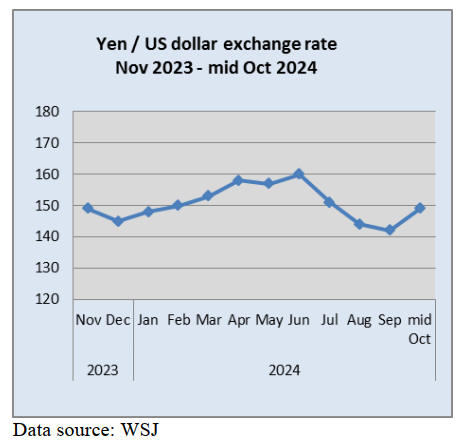
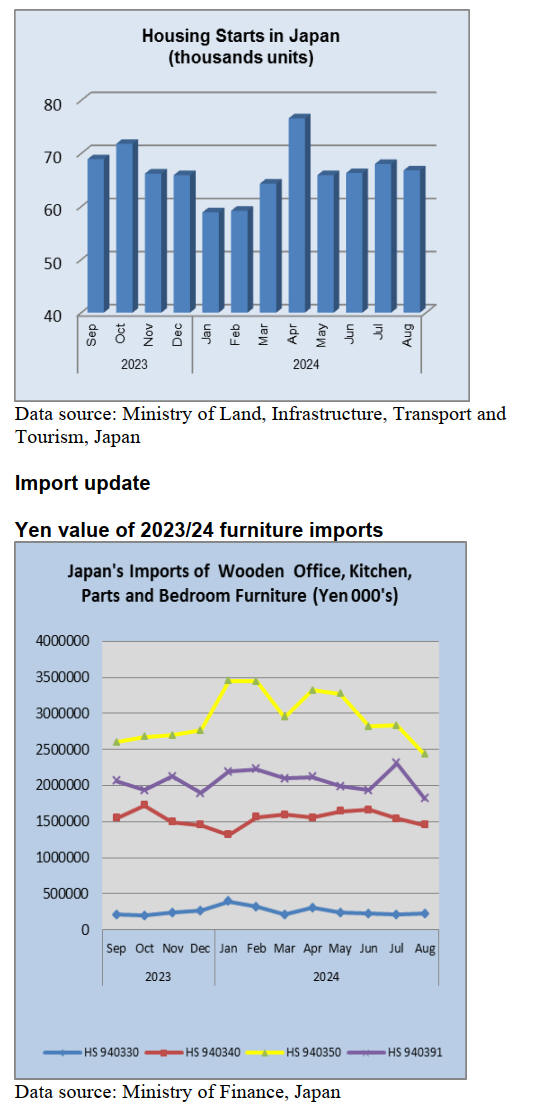
August 2024 wooden office furniture imports (HS
940330)
In August shippers in China accounted for most of wooden
office furniture imports to Japan at around 67% of the total
value of imports of HS940330. The other main shipments
in August were from Italy (16% of August imports and a
major increase from the average over the past months).
August arrivals from Italy added to the month on month
rise seen in July.
The other significant shipper in August was Malaysia
accounting for 9% of the value of imports but down
sharply from a month earlier.
Year on year, the value of Japan’s imports of wooden
office furniture in August were at around the same level as
in the previous month.

August 2024 kitchen furniture imports (HS 940340)
August marked the second month on month decline in the
value of arrivals of wooden kitchen furniture. Up to June
this year there was a steady increase in the value of
HS940340 imports mainly reflecting the weakness of the
yen against the US$ but from July and into August there
was a downward correction .
Year on year, the value of imports of wooden kitchen
furniture items (HS940340) in August fell 6% and month
on month there was a 14% decline.
The top shippers in August were the Philippines, 44% of
the total value of August arrivals in Japan but this was a
sharp downturn from the previous month. August import
values from shippers in Vietnam, China and Poland were
all higer than in the previous month. Vietnam accounted
for 35% of August imports of HS940340, China 8% and
Poland just over 1% (not shown in table).

August 2024 wooden bedroom furniture imports (HS
940350)
From mid-year there has been a steady decline in the value
of Japan’s imports of wooden bedroom furniture
(HS940350). This may reflect the slowdown in creation of
new hotel accommodation as tourist arrivals surged on the
back of the weak yen.
Shippers in China and Vietnam accounted for over 90% of
the value of Japan’s wooden bedroom furniture imports in
August with 58% coming from China and a further 35%
from Vietnam. Shipments from Malaysia and Thailand
combined accounted for around 5% of the value of August
imports
Year on year the value of August arrivals of wooden
bedroom furniture were up 11% but month on month there
was a 14% decline.
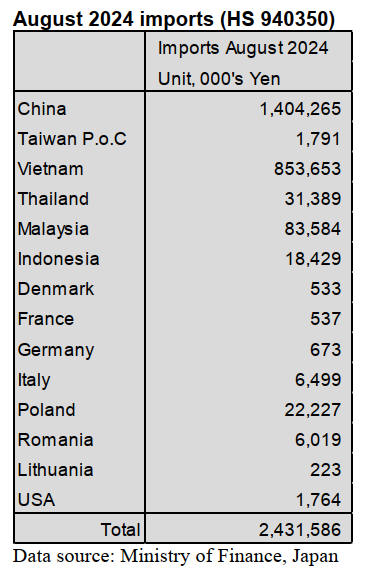
August 2024 wooden furniture parts imports
(HS 940391)
Arrivals of wooden furniture parts (HS940391) in August
were from a large number of suppliers, particularly those
in SE Asia supplying over 80% of the value of imports.
The top four shippers in August were China (43% of total
HS940391 imports) Indonesia (18%) Vietnam 13%) and
Malaysia (11%). August arrivals from China and
Indonesia were down sharply and the value of arrivals
from Vietnam and Malaysia were also below the value of
July arrivals.
Of all the shippers outside of Asia those in Germany, Italy
and Poland stand out as supplying wooden furniture parts
to Japan together accounting for just over 7% of the value
of August imports.
Year on year, the value of August imports of wooden
furniture parts was little changed but compared to a month
earlier the valus of August arrivals was down 21%
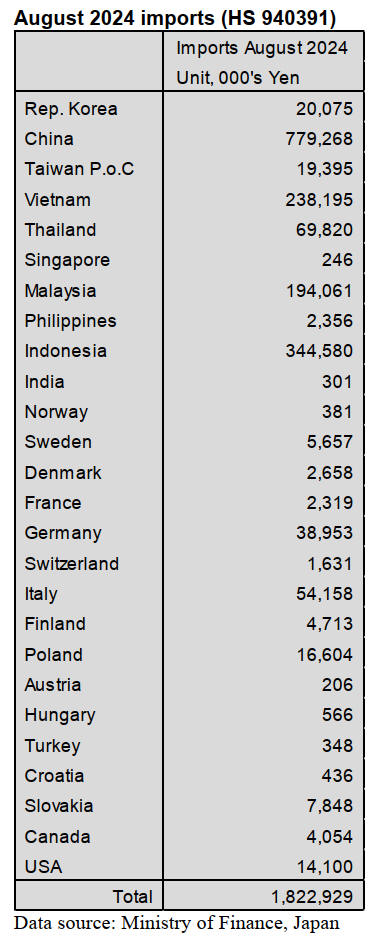
Trade news from the Japan Lumber Reports (JLR)
The Japan Lumber Reports (JLR), a subscription trade
journal published every two weeks in English, is
generously allowing the ITTO Tropical Timber Market
Report to reproduce news on the Japanese market
precisely as it appears in the JLR.
For the JLR report please see:
https://jfpj.jp/japan_lumber_reports/
Export logs and lumber
Volume of exporting logs during January to June, 2024 is
849,000 cbms, 12.3 % more than January to June, 2023.
The amount is 13.3 billion yen, 19.5 % more than the
same period last year. The volume and the amount of
exporting logs increase for consecutive two years.
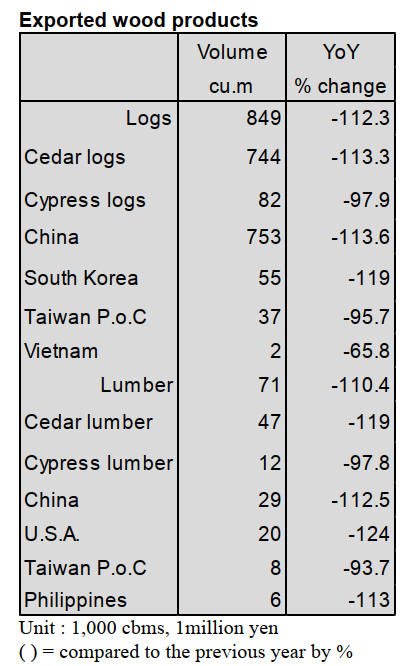
Volume of exporting lumber had kept decreasing since
2022 but it increases in 2024 and it is 71,000 cbms, 10.4 %
more than the same period last year. The amount of
exporting lumber is 3.4 billion yen, 12.3 5 more than the
same period last year.
Especially for logs, the high-priced logs and the weak yen
are double effects for rising amount. The forecast for the
second half of this year would be positive as same as the
firsthalf of this year.
The volume of exporting logs in 2024 would reach
1,700,000 cbms for the first time ever and the volume of
lumber would be more than 2023 for the first time in three
years. Cedar log is 744,000 cbms, 13.3 % more and cedar
lumber is 47,000 cbms, 19.0 % more than the first half of
2023. Exporting cedar logs to China is 671,000 cbms, 14.9
% up from the same period last year and it occupies 79 %
of total exporting logs. The exporting cedar lumber to
China declines but to the U.S.A. recovers.
On the other hand, exporting cypress log is 82,000 cbms,
2.1 % less than the first half of 2023. Cypress lumber is
12,000 cbms, 2.2 % down from the same period last year.
Exporting cypress log has been declining since 2022 and
exporting cypress lumber has been declining since 2021.
Cypress logs for South Korea, Taiwan P.o.C and Vietnam
decrease. Cypress lumber for South Korea decreases by
31.4 % declined. The reason is that the price of cypress
lumber has been high after the woodshcok in 2021.
Logs for China is 753,000 cbms, 13.6 % increased and
lumber for China is 29,000 cbms, 12.5 % increased from
the same period last year.
Demand for building materials is low but demand for
crating is still firm and there are inquiries to cedar logs due
to lower price than cypress’s price.
The price of 4 m cedar logs to China during January to
June, 2024 is US$115 – 119, C&F per cbm. The price was
around US$105 – 120, C&F per cbm during January to
June, 2023. A purchase price in this year is 11,000 yen, at
the port per cbm, and this is 500 – 1,000 yen up from the
same period last year. Lumber for the U.S.A. is 20,000
cbms, 24.0 % more than the same period last year.
However, the volume does not reach 36,000 cbms, which
was the peak at the first half of 2021, even though it is a
historical weak yen.
One of reasons is that there were not enough containers to
export lumber to the U.S.A. in June, 2024. Also, the
inquiries for lumber started to rise in spring this year.
55,000 cbms of logs are exported to South Korea and this
is 11.9 % increase. 3,000 cbms of lumber are exported to
South Korea and this is 5.3 % up from the same period last
year. Lumber for Philippines is 6,000 cbms, 13.0 % more
than the first half of 2023.
Use of wooden chips in 2023 the Ministry of Agriculture,
Forestry and Fisheries announced the result about the use
of wooden biomass energy in 2023. Wooden chips for
wood biomass power plants in 2023 are 11,497,906 BD
tons, and this is 4 % more than 2022.
The survey was held for 1,489 companies, which have
biomass power plants or boilers, and this is 53 companies
less than the previous year. 1,410 companies, 17
companies less than last year, had answered the survey.
1,349 out of 1,410 companies were effective responses
and the ratio of effective responses is 90.6 %. These
results do not include imported pellets nor PKS.
Thinned wood and forest scrap in 2023 are 4,924,398 BD
tons, 9.0 % more than 2022. This is 405,887 BD tons up.
The operations or new operations at medium or small
wood biomass power plants, which consume unused
woody materials, were stable. Scraps of lumber are
1,734,806 BD tons, 0.2 % up. Since the new starts are low,
there are a lot of wood offcuts of lumber and plywood,
from plants. Wastes of building material is 3,913,336 BD
tons, 0.7 % down from the previous year. This is also due
to less new starts.
Imported wooden chips and logs manufactured in Japan is
539,756 BD tons, 25.8 % more than 2022. Some
companies supplement domestic wooden chips in several
places. Pruned branches and others are 385,612 BD tons,
12.0 % less than last year. The reasons are that labor costs
and overhead expenses skyrocketed so there were less
opportunities to prune branches.
Joint meeting for plywood
There were five organisations, which are Japan Lumber
Importers’ Association, Japan Plywood Manufacturer’s
Association, APKINDO, Sarawak Timber Association,
and Sabah Timber Industries Association had a 24th joint
meeting for exports and imports of plywood on September
17, 2024. The joint meeting was held in Japan for the first
time in six years.
Representatives from each organisation reported its market
and economic conditions. Some suppliers of South Sea
plywood requested Japanese buyers’ cooperation to
protect the resource. There were several softwood
plywood manufacturers, trading companies and
wholesalers in Japan attended the joint meeting.
The chairman of Japan Plywood Manufacturer’s
Association said that it is important to cooperate for
competing against wooden panels such as OSB or MDG.
There was an opinion about the high export cost from the
chairman of APKINDO and the foresters in South Asia
have been struggling with loss.
A report of the market from Indonesia was to preserve the
forest resources by afforestation. This is one of
Indonesia’s measures. As for plywood, the price kept
dropping after COVID-19 but the production cost kept
rising. As a result, the added value of plywood is not good.
They will raise awareness of using natural wood material
such as lauan wood and measure the quality of products.
Moreover, they will advocate the value of products instead
of the price.
A Malaysian representative proposed other countries to
cover the cost because the cost has been increasing.
Budget request for 2025
The budget request was made by The Ministry of Forestry
and Fisheries. 347.8 billon yen was requested and this was
15.8 % more than it was planned at first. The budget will
be used for carbon neutrality, and a solution of hay fever
in wood, forestry and lumber industries. The budget
request for 2025 is 2 % less than 2024.
The details of the budget request are 233.4 billion yen for
public projects such as forest management and
afforestation projects, 17.8 % more than the first budget
request and 114.3 billion yen, 12 % more than the first
budget request, for non-public projects.
As for Green Growth Strategy Through Achieving Carbon
Neutrality 2050, 15.6 billion yen, 8.3 % more than first
budget request, was requested. A policy objective is to
supply and use 42,000,000 cbms domestic lumber in 2030.
This is 20 % more than 2022’s policy objective and this is
9.2 % more than the first budget request. 300 million yen
is for comprehensive package of digital innovation.
However it is and this is 25 % less than the first budget
request. 1.2 billion yen is to strengthen in supplying and
using more structural lumber and it is 20 % more than the
first budget request. About hey fever measures, about 20
% of cedar artificial forest will be reduced.
The supplementary budget in last year was 6 billion yen
but the budget request for next year is 3.5 billion yen. The
details of 3.5 million yen are 700 million yen for cutting
down the cedar artificial forest and replanting, 1.5 billion
yen for expanding use of cedar lumber and 700 million
yen for expanding production of seedlings with less
pollen. The budget request for the forest management is
148.9 billion yen, 18.7 % more than the first budget
request.
|